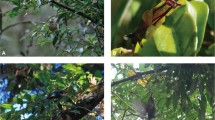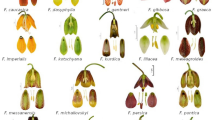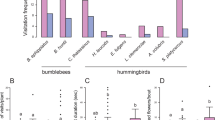Abstract
The spectacular red helleborine orchid (Cephalanthera rubra) is distributed from Iran throughout the Mediterranean region and up to western Europe, reaching southern Scandinavia1. The plant preferably grows on calcareous soils in dry woods2. The elongate, loose inflorescence usually bears 4–10 brilliantly rose-coloured flowers which completely lack nectar or other food for anthophilous insects and thus act by deceit3. Flower-visitors so far reported are bees4–6, especially males of the solitary bees Chelostoma fuliginosum (Pz.) (= Chelostoma rapunculi (Lep.) = Chelostoma nigricornis (Nyl.)) and Chelostoma campanularum (K.) (Megachilidae). Females of the two Chelostoma species collect pollen for their brood almost exclusively from bellflowers (Campanula)7. Mate-seeking flights, feeding and resting of the males are strongly associated with Campanula flowers. I now report that C. rubra mimics the floral coloration of Campanula in the bee visual system and thereby receives pollination service by the Chelostoma males. Pollination is regularly effected by males of C. fuliginosum. The orchid peaks in anthesis distinctly before Campanula, phenologically matching and efficiently exploiting the male bee population.
This is a preview of subscription content, access via your institution
Access options
Subscribe to this journal
Receive 51 print issues and online access
$199.00 per year
only $3.90 per issue
Buy this article
- Purchase on Springer Link
- Instant access to full article PDF
Prices may be subject to local taxes which are calculated during checkout
Similar content being viewed by others
References
Sundermann, H. Europäische und mediterrane Orchideen (Schmersov, Hildesheim, 1980).
Summerhayes, V. S. Wild Orchids of Britain (Collins, London, 1951).
Daumann, E. Feddes Rep. 80, 463–590 (1970).
Godfrey, M. J. J. Bot. 60, 359–361 (1922).
Evans, G. H. Proc. R. ent. Soc. Lond. A5, 101–103 (1930).
Evans, G. H. Proc. R. ent. Soc. Lond. A6, 59 (1931).
Käpylä, M. Biol. Res. Rep. Univ. Jyväskylä 5, (1978).
Alcock, J. et al. Zool. J. Linn. Soc. 64, 293–326 (1978).
Delpino, F. Atti Soc. Ital. Sci. Nat. Milano 16–17, 1–351 (1873–74).
Nilsson, L. A. Nord. J. Bot. 1, 461–480 (1981).
Godfrey, M. J. Proc. R. ent. Soc. Lond. A3, 60–61 (1928).
Dafni, A., Ivri, Y. & Brantjes, N. B. M. Acta bot. neerl. 30, 69–73 (1981).
Käpylä, M. Ann. ent. Fenn. 44, 63–64 (1978).
Godfrey, M. J. Monograph and Iconograph of British Orchideceae (Cambridge University Press, 1933).
Dafni, A. & Ivri, Y. Pl. Syst. Evol. 137, 229–240 (1981).
Tutin, T. G. et al. Flora Europaea (Cambridge University Press, 1964–80).
Kevan, P. G. Linn. Soc. Symp. Ser. 6, 51–78 (1978).
Menzel, R. Handbk. sens. Physiol. 7/6A, 503–579 (1979).
Author information
Authors and Affiliations
Rights and permissions
About this article
Cite this article
Nilsson, L. Mimesis of bellflower (Campanula) by the red helleborine orchid Cephalanthera rubra. Nature 305, 799–800 (1983). https://doi.org/10.1038/305799a0
Received:
Accepted:
Issue Date:
DOI: https://doi.org/10.1038/305799a0
This article is cited by
-
Improving conservation and translocation success of an endangered orchid, Caladenia xanthochila (Orchidaceae), through understanding pollination
Plant Ecology (2023)
-
Who helps whom? Pollination strategy of Iris tuberosa and its relationship with a sexually deceptive orchid
Journal of Plant Research (2016)
-
Pollination system and the effect of inflorescence size on fruit set in the deceptive orchid Cephalanthera falcata
Journal of Plant Research (2015)
-
Low pollination success of hybrids between nectar-rewarding and food-deceptive orchids
Plant Systematics and Evolution (2014)
-
Floral visual signal increases reproductive success in a sexually deceptive orchid
Arthropod-Plant Interactions (2012)
Comments
By submitting a comment you agree to abide by our Terms and Community Guidelines. If you find something abusive or that does not comply with our terms or guidelines please flag it as inappropriate.



